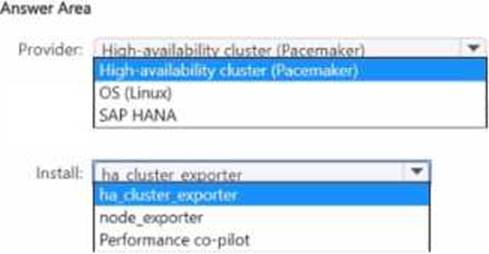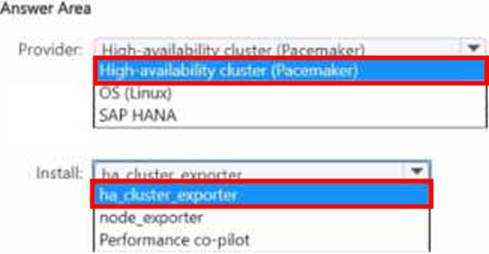Practice Free AZ-120 Exam Online Questions
Note: This section contains one or more sets of questions with the same scenario and problem. Each question presents a unique solution to the problem. You must determine whether the solution meets the stated goals. More than one solution in the set might solve the problem. It is also possible that none of the solutions in the set solve the problem.
After you answer a question in this section, you will NOT be able to return. As a result, these questions do not appear on the Review Screen. You have an on-premises datacenter.
You have an Azure subscription that contains a virtual network named VNet1.
You have an SAP RISE managed workload.
You need to ensure transitive connectivity between the datacenter. VNet1, and the managed workload.
Solution: You configure a Site-to-Site (S2S) VPN connection between the datacenter and VNet1 and an S2S VPN connection between VNet1 and the managed workload.
Does this meet the goal?
- A . Yes
- B . NO
You need direct connectivity from an on-premises network to SAP HANA (Large Instances).
The solution must meet the following requirements:
✑ Minimize administrative effort.
✑ Provide the highest level of resiliency.
What should you use?
- A . ExpressRoute Global Reach
- B . Linux IPTables
- C . ExpressRoute
- D . NGINX as a reverse proxy
C
Explanation:
https://docs.microsoft.com/en-us/azure/virtual-machines/workloads/sap/hana-network-architecture
Express Route Global Reach Microsoft introduced a new functionality called ExpressRoute Global Reach. Global Reach can be used for HANA Large Instances in two scenarios: Enable direct access from on-premises to your HANA Large Instance units deployed in different regions Enable direct communication between your HANA Large Instance units deployed in different regions Direct Access from on-premises In the Azure regions where Global Reach is offered, you can request enabling the Global Reach functionality for your ExpressRoute circuit that connects your on-premises network to the Azure virtual network that connects to your HANA Large Instance units as well.
You have an Azure subscription. The subscription contains a virtual machine named Server1 that runs Windows Server and hosts SAP Central Services (SCS). To Server1. you deploy the new version of the Azure VM Extension for SAP solutions. You need to validate whether the extension is collecting performance metrics.
What should you do on Server1?
- A . From Microsoft Edge, navigate to http://127.0.0.1:11812/azure4sap/metrics.
- B . Run the Get-AzMetric cmdlet.
- C . Run the Get-AzVMDiagnosticsExtension cmdlet.
- D . From Microsoft Edge, navigate to http://169.254.169.254/metadata/instance?api-version=2021-02-01.
You are evaluating the migration plan.
Licensing for which SAP product can be affected by changing the size of the virtual machines?
- A . SAP Solution Manager
- B . PI
- C . SAP SCM
- D . SAP ECC
D
Explanation:
Scenario: Increase the performance of SAP ECC applications by moving to SAP HANA.
Reference: https://azure.microsoft.com/en-us/pricing/details/virtual-machines/rhel-sap-hana/
You plan to deploy an SAP production landscape that uses SAP HANA databases on Azure.
You need to configure the storage infrastructure to support the SAP HANA deployment The solution must meet the SAP issued requirements for data throughput and I/O.
How should you configure the storage?
- A . RAID1
- B . RAID5
- C . RAID0
- D . RAID6
You have an SAP environment on Azure.
our on-promises network connects to Azure by using a site-to-site VPN connection.
6u need to alert technical support if the network bandwidth usage between the on-premises network and Azure exceeds 900 Mbps 10 minutes.
What should you use?
- A . Azure Network Watcher
- B . NIPING
- C . Azure Monitor
- D . Azure Enhanced Monitoring for SAP
C
Explanation:
You set up alerts on Azure VPN Gateway metrics. Azure Monitor provides the ability to set up alerts for Azure resources. You can set up alerts for virtual network gateways of the "VPN" type.
Metric: AverageBandwidth: Average combined bandwidth utilization of all site-to-site connections on the gateway.
Reference: https://docs.microsoft.com/bs-latn-ba/azure/vpn-gateway/vpn-gateway-howto-setup-alerts-virtual-network-gateway-metric
You deploy an SAP landscape on Azure.
You plan to use an Azure Automation account to stop the SAP virtual machines outside of business hours.
You need to ensure that you can use Azure Automation runbook a for the virtual machines.
What does the Azure Automation account require?
- A . an Azure Storage account
- B . an Azure App Service WebJob
- C . a Recovery Services vault
- D . a Run As account
You have an on-premises SAP environment that uses AIX servers and IBM DB2 as the database platform.
You plan to migrate SAP to Azure. In Azure, the SAP workloads will use Windows Server and Microsoft SQL Server as the database platform.
What should you use to export from DB2 and import the data to SQL Server?
- A . R3load
- B . Azure SQL Data Warehouse
- C . SQL Server Management Studio (SSMS)
- D . R3trans
A
Explanation:
Both R3load and SSMA can be used to migrate from DB2 to SQL Server. In the options there is not SSMA, but SSMS, the SSMS cannot be use to migrate DB2 to SQL Server. please refer to: https://techcommunity.microsoft.com/t5/running-sap-applications-on-the/sap-os-db-migration-to-sql-server-faq/ba-p/366986
https://sapnwnewbie.blogspot.com/2013/07/osdb-migration-cmd-str-toc-ext-r3load.html
https://docs.microsoft.com/en-us/sql/ssma/sql-server-migration-assistant?view=sql-server-ver15
https://docs.microsoft.com/en-us/sql/ssms/sql-server-management-studio-ssms?view=sql-server-ver15
You have an Azure subscription.
You plan to deploy an SAP production landscape on Azure
You need to select a support plan.
The solution must meet the following requirements:
• Respond to critical impact incidents within one hour.
• Minimize costs.
What should you choose?
- A . Professional Direct
- B . Standard
- C . Basic
- D . Premier
HOTSPOT
You have a SUSE Linux Enterprise Server (SLES) duster that runs SAP HANA.
You plan to use Azure Monitor for SAP Solutions to collect STONITH block device (SBD) metrics from the cluster.
Which provider should you use. and what should you install on each cluster node? To answer, select the appropriate options in the answer area. NOTE: Each correct selection is worth one point.


